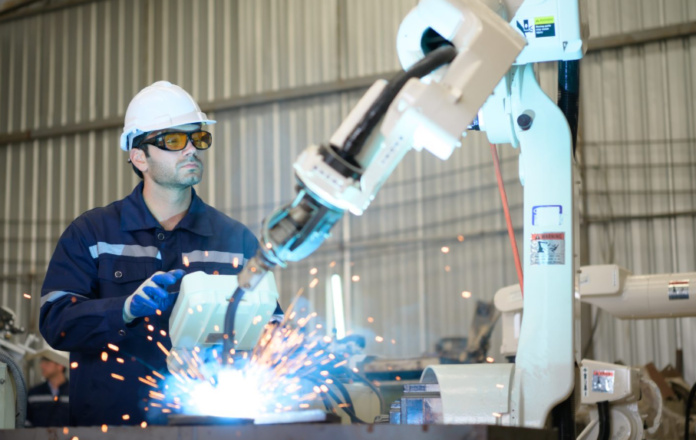Welding automation is transforming modern manufacturing by making production faster, safer, and more precise. Unlike manual welding, automated systems can work continuously, reduce mistakes, and handle complex tasks with consistent quality. As factories strive for higher efficiency and safer workplaces, welding automation has become essential for production lines of all sizes. This article explores the key benefits of welding automation and explains why it has become essential in modern industrial operations.
Benefits #1: Efficiency Improvements in Robotic Welding
Robotic welding significantly boosts manufacturing efficiency by transforming how welding tasks are performed. Here’s how:
- Faster Production: Robots can work continuously without fatigue, allowing production to run 24/7. Automated welding systems keep a consistent speed and accuracy, finishing tasks faster than manual welding. This helps factories meet deadlines more efficiently and handle higher production volumes.
- Optimized Labor: Robots handle repetitive or dangerous tasks, allowing workers to focus on more valuable work. This reduces labor costs, lowers physical strain, and more productive workplace.
- Reduced Material Waste: Robotic welding applies materials accurately, minimizing waste and spatter. Consistent welds also reduce defects and rework, saving materials and cutting costs.
Robotic welding improves manufacturing efficiency by increasing production speed, making better use of labor, cutting material waste, and ensuring consistent quality. This results in lower costs, safer workplaces, and greater competitiveness for manufacturers.
Benefits #2: Safety Improvements in Industrial Robot Welding
Industrial robot welding enhances workplace safety by taking over dangerous tasks, ensuring compliance with safety standards, and creating a safer environment for workers.
- Worker Protection: Robots handle hazardous tasks such as welding near extreme heat, sparks, and toxic fumes. This reduces workers’ exposure, lowering the risk of burns, eye injuries, and long-term respiratory problems.
- Compliance with Safety Standards: Robotic welding helps factories meet safety regulations, including OSHA standards, by reducing workplace accidents and promoting safer work practices.
- Safer Work with Cobots: Collaborative robots (cobots) are designed to work safely alongside humans. Equipped with sensors and speed controls, they detect human presence and prevent accidents, enabling secure human-robot interaction.
By automating dangerous tasks, ensuring regulatory compliance, and using cobots for safe collaboration, robotic welding creates a safer, more efficient, and more protected manufacturing environment.
See also: Source Celsius Juneorbachctech
Benefits #3: Precision and Quality in Robotic Welding
Robotic welding ensures consistently precise and high-quality welds, even for complex tasks.
- Consistent, Repeatable Welds: Robots are programmed to perform the same task with exact precision every time. This consistency minimizes errors and reduces the need for rework, enhancing overall product quality.
- Handling Complex Tasks: Modern robotic welders can manage intricate or large-scale projects, including multi-layer welds and complex joint geometries. Advanced features like adaptive heat control and multi-pass programming allow robots to execute thick or detailed welds accurately.
- Monitoring and Quality Control: Robots use sensors and cameras to monitor welding in real time. Laser and vision systems guide robots for precise, consistent welds. These technologies maintain high-quality standards throughout production.
By delivering consistent welds, handling complex tasks with precision, and using advanced monitoring systems, robotic welding enhances manufacturing efficiency, product reliability, and overall quality.
Key Components of Welding Automation Systems
Welding automation depends on four essential components:
- Welding Robots: These robots perform precise multi-axis movements, regulate heat accurately, and use offline programming to simulate weld paths before production. This ensures consistent, high-quality welds across complex or repetitive tasks.
- Positioners and Manipulators: These devices adjust the angle and orientation of workpieces with high precision. They provide 360-degree access to seams, stabilize large or off-center parts, and reduce the need for re-clamping, enabling accurate and efficient welding.
- Sensors and Controllers: Real-time sensors monitor weld conditions such as arc voltage, wire feed, and seam alignment. Controllers process this data instantly, adjusting torch positions as needed and logging information for quality control. This helps address skilled labor shortages while maintaining consistent weld quality.
- Software and Programming: Advanced software integrates CAD data with robotic motion to plan weld paths, avoid collisions, optimize parameters, and predict distortion. Acting as the digital backbone of automation, it enables precise customization and faster production setup.
These components create a highly efficient, precise, and reliable welding process, ensuring repeatable quality and productivity in modern manufacturing.
Applications of Robotic Welding Across Industries
General Manufacturing
Robotic welding is widely used in general manufacturing to handle complex shapes and large components. Advanced features like seam tracking, adaptive power control, and multi-axis motion allow robots to weld with high accuracy. Real-time sensors monitor the weld, automatically adjusting the torch to prevent errors and minimize heat damage. This makes robotic welding ideal for producing heavy equipment frames, pressure vessels, and other structural components in high volumes.
Automotive Manufacturing
In automotive production, robots perform spot, MIG, and laser welding on car chassis and body parts. Robotic arms maintain consistent pressure, while vision systems detect misaligned parts and adjust settings instantly.
Aerospace and Defense
Robotic welding is essential in aerospace and defense for producing parts that meet strict safety standards. Robots use precise welding techniques to produce key components like rocket engine nozzles, fuselage joints, and turbine parts. They follow seams with high accuracy to create strong, reliable welds, and every weld is recorded to ensure quality and safety.
Robotic welding enhances manufacturing across industries by delivering high precision, consistent quality, improved safety, and greater efficiency.
Future Trends in Welding Automation
Welding automation is advancing with new technologies that make manufacturing smarter, safer, and more accessible. Key trends shaping the future include:
AI and Machine Learning
AI and machine learning enable welding systems to adjust in real time, optimize welding parameters, and detect defects automatically. This improves weld quality, reduces errors, and boosts overall productivity.
Energy-Efficient and Eco-Friendly Systems
Sustainability is driving the development of energy-efficient welding systems. These machines consume less energy, produce fewer emissions, and help factories meet environmental standards while cutting operating costs.
Expansion to Small and Medium-Sized Enterprises (SMEs)
Collaborative robots (cobots) are making automation accessible to smaller manufacturers. They can safely work alongside humans, are easy to program, and handle high-mix, low-volume production. This allows SMEs to enhance productivity without large investments.
Increased Use of Collaborative Robotics
Cobots (collaborative robots) are being used more in welding because they are flexible and safe. They help workers by guiding welds and adjusting settings, making production faster, more efficient, and safer.
The future of welding automation will be smarter, more environmentally friendly, and better at working alongside humans. This means more manufacturers can use advanced technology to boost productivity, improve quality, and keep workers safer.
Conclusion
Welding automation is transforming manufacturing by making production faster, safer, and more accurate. Robots help factories run more efficiently by working continuously, using labor more effectively, reducing material waste, and creating consistent, high-quality welds. They also improve safety by taking on dangerous tasks and working safely alongside humans through collaborative robots, or cobots.
Used in industries from general manufacturing to aerospace, automation increases productivity, quality, and safety. New technologies are making welding smarter, greener, and easier, helping manufacturers stay competitive.



